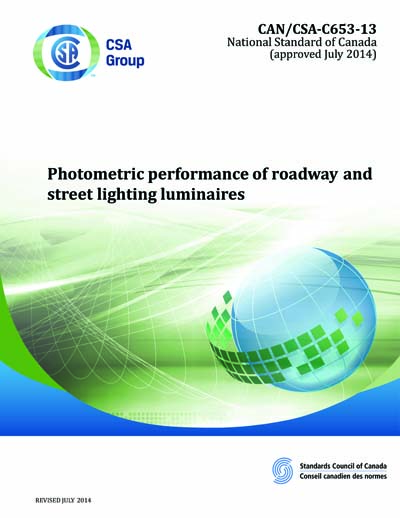Historical
CSA C653-2013
C653-13 - Photometric performance of roadway and street lighting luminaires
Preface
This is the fourth edition of CSA C653, Photometric performance of roadway and street lighting luminaires. It supersedes the previous editions published in 2008, 1994, and 1992 under the title Performance Standard for Roadway Lighting Luminaires. This Standard establishes the minimum performance requirements for roadway and street lighting luminaires. The requirements of this Standard are in addition to those specified in CSA C22.2 No. 250.0 and CAN/CSA-C22.2 NO. 250.13. This new edition includes cobra head and shoe box using high pressure sodium (HPS), metal halide (MH), induction, and light emitting diodes (LED) light sources.Scope
1.1 This Standard specifies photometric performance requirements for luminaires that are used for roadway and street lighting applications. 1.2 The following light sources are addressed in this Standard: a) clear HPS lamp; b) clear metal halide lamp; c) induction; and d) LED. Note: Future editions of this Standard might include other light sources, such as plasma. 1.3 This Standard is based on a) average luminance, luminance uniformity ratio, and veiling luminance ratio as defined in ANSI/IES RP-8; b) nominal input power in watts for HID sources; c) rated lamp lumens for HID sources; d) luminaire input power in watts and rated luminaire lumens for Induction and LED sources; and e) absolute photometry for LED sources as per IES LM 79. 1.4 This Standard is not a design document, and is intended to establish luminaire photometric performance efficiency only. Tables 4A, 4B, 5A, 5B, 6, and 7 are intended to be used to establish maximum unit power density (UPD) values for typical applications as per the parameters listed in Table 1. UPD values provided in this Standard are not intended for specification or application purposes. Notes: 1) The UPD values for MH luminaires in Table 5A and 5B do not include ballast losses and ballast factor (BF). The UPD values for all applications include a light loss factor of 1 (LLF =1.0). 2) It is the responsibility of designers to select the optimal combination of fixture type, pole height, and spacing to ensure an optically efficient design. For guidance on design, see ANSI/IES RP-8. 1.5 In this Standard, shall is used to express a requirement, i.e., a provision that the user is obliged to satisfy in order to comply with the standard; should is used to express a recommendation or that which is advised but not required; and may is used to express an option or that which is permissible within the limits of the Standard. Notes accompanying clauses do not include requirements or alternative requirements; the purpose of a note accompanying a clause is to separate from the text explanatory or informative material. Notes to tables and figures are considered part of the table or figure and may be written as requirements. Annexes are designated normative (mandatory) or informative (non-mandatory) to define their application. 1.6 The values given in SI (metric) units are the standard. The values given in parentheses are for information only.CSA America, Inc. [csa]

